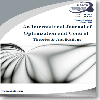Simulation of glucose regulating mechanism with an agent-based software engineering tool
Simulation of glucose regulating mechanism with an agent-based software engineering tool
___
- [1] Jhonstone, K., & Adam, K. (2012). The Human: As a Biological System. Core Body of Knowledge for the Generalist OHS Professional. Safety Institute of Australia Ltd, Tullamarine, Victoria, Australia
- [2] Marieb, E.N., & Hoehn, K. (2010). Human Anatomy and Physiology. 8th ed., San Francisco: Benjamin Cummings, 634-654.
- [3] Guyton, A.C., & Hall J.E. (2006). Textbook of Medical Physiology. Elseiver Inc, 11th ed.
- [4] Klügl, F. & Bazzan, A.L.C. (2012). Agent-Based Modeling and Simulation. Association for the Advancement of Artificial Intelligence, 29-40.
- [5] Bandini, S., Manzoni, S.T., & Vizzari, G. (2009). Agent Based Modeling and Simulation: An Informatics Perspective. Journal of Artificial Societies and Social Simulation, vol. 12.
- [6] Bonabeau, E. (2002). Agent-based modeling: Methods and techniques for simulating human systems. Proceedings of the National Academy of Sciences of the United States of America (PNAS), 99(3), 7280-7287.
- [7] Bora, Ş., Evren, V., Emek, S., & Çakırlar, I. (2017). Agent-based modeling and simulation of blood vessels in the cardiovascular system. Simulation: Transactions of the Society for Modeling and Simulation International, 1-16. Doi: 10.1177/0037549717712602
- [8] DeAngelis, D.L., & Grimm V. (2014). Individualbased models in ecology after four decades. F1000Prime Reports; 6:39. DOI: 10. 12703/P6-39
- [9] Macal, C.M., & North, M.J. (2010). Tutorial on agent-based modelling and simulation. Journal of Simulation, 4:151-162. DOI: 10.1057/jos.2010.3
- [10] Ramaprased, R. (1983). On the Definition of Feedback. Behavioral Science, 28(1):4-13.
- [11] Nikolai, C., & Madey, G. (2009). Tools of the trade: a survey of various agent based modeling platforms. J. Artif. Soc. Social Simul., vol. 12.
- [12] James, P., & McFadden R. (2004). Understanding the processes behind the regulation of blood glucose. Diabetes Knowledge, 100(16):56-58.
- [13] Bora, Ş., Emek, S., Evren, V. (2017). An Agentbased Approach in Homeostatic Control Systems: Thermoregulation. IEEE 9th International Conference on Computational Intelligence and Communication Networks, 113-116. DOI: 10.1109/CICN.2017.8319367
- [14] Wang, X., Misava, R., Zielinski, M.C., Cowen, P., Jo, J., Periwal, V., Ricordi, C., Khan, A., Szust, J., Shen, J., Millis, J.M., Witkowski, P., & Hara, M. (2013). Regional Differences in Islet Distribution in the Human Pancreas - Preferential Beta-Cell Loss in the Head Region in Patients with Type 2 Diabetes. PloS One, vol. 8(6).
- [15] Krull, D.L., & Peterson, R.A. (2011). Preclinical Applications of Quantitative Imaging, Cytometry to Support Drug Discovery. Methods in Cell Biology, Chapter 11, vol. 102, 291-308.
- [16] Berg, J.M., Tymoczko, J.L., & Stryer, L. (2002). Glycogen Metabolism. Biochemistry. 5th edition, Chapter 21. Available from: https://www.ncbi.nlm.nih.gov/books/NBK21190/ Accessed 17 August 2018.
- [17] Buppajarntham, S., & Junpaparp, P. (2014). Insulin, Referance Range. Available from: https://emedicine.medscape.com/article/2089224- overview. Accessed 17 August 2018.
- [18] Genuth, S.M. (1973). Plasma Insulin and Glucose Profiles in Normal, Obese, and Diabetic Persons. Ann Intern Med. Vol. 79(6), 812–822. doi: 10.7326/0003-4819-79-6-812
- [19] Austin Community College. Glucose Regulation. Available from: http://www.austincc.edu/apreview/EmphasisItems/ Glucose_regulation.html. Accessed 17 August 2018.
- [20] Krinsley, J.S., & Preiser, J-C. (2015). Time in blood glucose range 70 to 140 mg/dl > 80% is strongly associated with increased survival in nondiabetic critically ill adults. Krinsley and Preiser Critical Care, 19:179. DOI 10.1186/s13054-015- 0908-7
- ISSN: 2146-0957
- Yayın Aralığı: 4
- Yayıncı: Prof. Dr. Ramazan YAMAN
On the explicit solutions of fractional Bagley-Torvik equation arises in engineering
An application of fuzzy linear modeling: prediction of uncertainty for betaglucan content
A comparison of some control strategies for a non-integer order tuberculosis model
A Boiti-Leon Pimpinelli equations with time-conformable derivative
Kamal Ait TOUCHENT, Zakia HAMMOUCH, Toufi MEKKAOUI, Canan UNLU
Approximate controllability of nonlocal non-autonomous Sobolev type evolution equations
Arshi MERAJ, Dwijendra NARAIN PANDEY
Ilker KUCUKOGLU, Tulin GUNDUZ, Fatma BALKANCİOGLU, Emine CHOUSEIN TOPAL, Oznur SAYİM
A new auxiliary function approach for inequality constrained global optimization problems
Nurullah YİLMAZ, Ahmet SAHİNER
Ana R.M. CARVALHO, Carla M.A. PINTO, Jo˜ao Nuno TAVARES
Analysis of boride layer thickness of borided AISI 430 by response surface methodology
